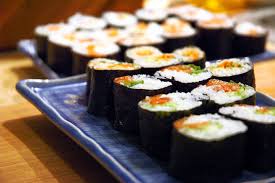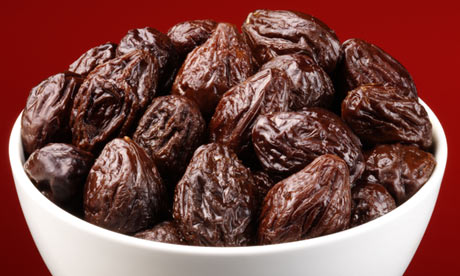
Have you tried making sushi before? It is something I first started making about a year ago. My husband and I spent an evening as a date night learning the art of sushi making through a Group On deal. It was great fun and I was surprised at how easy it was to make and also how tasty it was. It has inspired me to try other Japanese cooking. The Yo Sushi Cookery book has been a very good source for recipes. The main ingredients of Japanese cooking are rice, miso, mirin, wasabi, fish, green vegetables and seaweed. These are now widely available in the major supermarkets. (I have seen them in Asda, Sainsburys and Waitrose). If you make sushi regularly it is probably cheaper to order ingredients in larger quantities on-line. I have used sushisushi.co.uk before. These ingredients are all healthy and low in calories. This probably explains why Japan is one of the healthiest countries in the world. It has the lowest obesity levels (5% of the population) and the highest life expectancy. Japanese cooking is in itself quite simple food and is prepared and eaten where possible in its natural form.
The secret to good sushi is learning how to cook the rice. Sushi rice is high in starch and very sticky when cooked. In order to get rid of some of the starch it should be rinsed before cooking. It will take several rinses in cold water until the water becomes clear and should then be then left to drain. When cooking sushi rice the quantity of water is also important. It is always 10% more than the quantity of rice. eg. If you are cooking 100g of rice you need 110ml of water, This should be cold water placed in a thick based pan with a tight fitting lid. Place the lid on the pan and bring up to the boil (this takes 5-7 minutes). You must resist the urge to take the lid off and see how it is doing as it is important to keep the steam inside the pan. You will learn to hear when it is boiling. When the water has come up to the boil the rice will then need another 5-7 minutes to cook. The heat is then turned off and the rice left to cook for a further ten minutes in the steam from the pan. The lid still remains on.
Sushi vinegar is added to the cooked rice while it is still hot in order to create sushi rice. The three main ingredients for this are rice vinegar, sugar and salt. These are combined in a non metallic bowl and then stirred carefully into the rice with a spatula. Do not over stir or the rice will become mushy.
The fillings for sushi are very varied. People normally think of raw fish (salmon and tuna) but there are lots of vegetable fillings you can use (asparagus, avocado, pepper and cucumber). I have even seen a recipe in the Yo Sushi book for chocolate and mango sushi! (I haven't tried it yet!) You can also accompany any of these fillings with some wasabi paste. This is made from an aquatic plant in Japan and has a distinct strong flavour like horseradish (beware you only need a small amount as it is very hot!)
To make the traditional sushi rolls (called maki) you will need a rolling mat. You can buy these from supermarkets as well (I have seen them in Waitrose and online with Ocado). This should be covered with cling-film to make it easier to roll the sushi.
Prepare the fillings that you are using and then you are ready to roll! As sushi rice is very sticky you will need to make a vinegar that you can dip your fingers into to keep them clean while you are making the Sushi . It is important not to use too much rice and to spread it out thinly (just under a cm thick). I find that if you use too much then it is hard to roll and won't end up looking so neat and delicate. Rolling does take practice.
When you are ready to eat put out some plates and chopsticks. Fill some bowls with soy sauce, toasted sesame seeds, which are great for dipping the sushi into.
If you haven't made Sushi before I hope this inspires you to give it a go. Not only is it delicious it is also very attractive and would be a great thing to serve if you were having friends round for a meal. It is also a fun thing to make with someone else and eat together.
Traditional Maki sushi
Makes 4 rolls (24 pieces)
240g Sushi rice
268ml of cold water
1 portion of sushi vinegar (see below)
1 portion of tezu vinegar (see below)
2 Nori sheets
Fillings of your choice. some good ideas are
Salmon and chives
Salmon and cucumber
Salmon and avocado
Avocado and sasame seeds
Cooked asparagus and sesame seeds
Fresh tuna
Red or yellow peppers
Sushi vinegar
25ml of rice vinegar
15g-25g of sugar (the amount of sugar varies depending on personal taste, but a less sweet vinegar is generally used for raw fish and a sweeter one for vegetables)
7g of salt
Combine these in a non metallic bowl and stir well until the sugar has dissolved
Tezu water vinegar
200ml of water
2 tablespoons of rice vinegar
1 teaspoon of salt
Combine these in a bowl and set aside
Cooking rice for Sushi
Rinse the rice through a sieve, draining away the milky water and repeat 3-5 times until the water runs clear. Leave to drain for an hour so that the rice has time to absorb moisture
Put the rice in a heavy based medium saucepan with the cold water
Place the lid on the pan and bring up to the boil (listen for boiling sound) which will take 5-7 minutes
Lower the heat to a gentle simmer and cook for another 5-7 minutes
Turn the heat off and leave the rice with the lid on for another 10 minutes
Transfer to a non metallic bowl and stir in the prepared sushi vinegar
Leave until cool enough to handle
Assembling Maki Rolls
Cover the rolling mats with clingfilm
Cut the nori sheets in half lengthwise
Place nori sheet on a rolling mat, shiny side down about 1cm from the edge of the mat closest to you and with equal space on each end
Wet your hands in the tezu vinegar
Take a handful of the sushi rice and gently press the rice in the centre of the nori sheet. Spread the rice thinly (just under a cm) leaving a cm strip along the top edge uncovered
Place your filling in the centre of the the rice
Use your thumbs to lift the edge of the rolling mat closest to you over the filling, forming it into a roll
Lift the top of the rolling mat and turn the roll a little to overlap the edges of the nori and seal the roll
When the edges come in contact they seal themselves
Roll again, exerting gentle pressure to ensure it will keep its shape and remain sealed
Remove from the rolling mat and use a very sharp knife to slice the roll into six equal segments
Repeat with the remaining ingredients (you may not need all the rice)
Chill for 2-3 hours or overnight
Serve with toasted sesame seeds, soy sauce and pickled ginger
